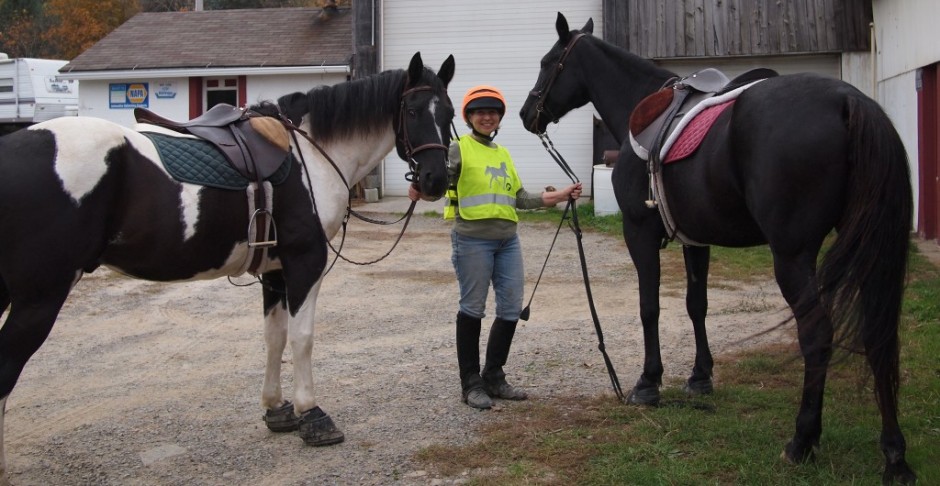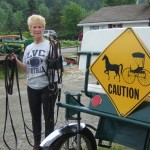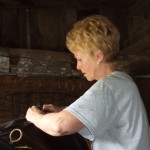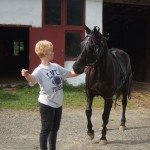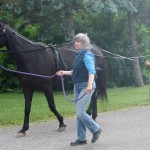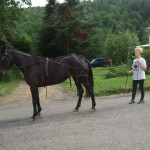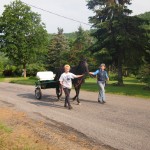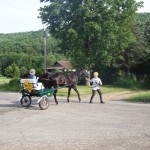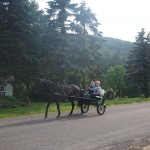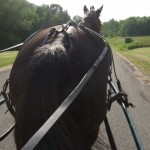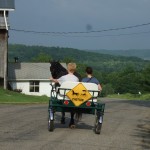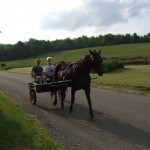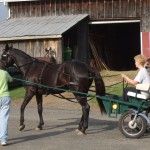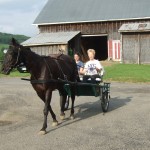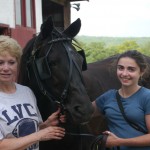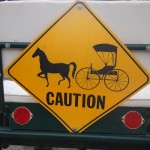“Hi Donna, how are you?” I said.
“Fine,” she replied. “I’m ready to put the harness on.”
“Can I do anything to help?” I asked.
“In a minute, I need to get the harness,” she replied. Donna walked to the tack room and came back with the equipment.
“I like to go slow. Pepper hasn’t been harnessed and driven for about eight years,” said Donna. “It’s better to go over the basics with her before we get into the cart.”
“That sounds like a good idea,” I replied. “Pepper can be skittish.”
She picked up the harness saddle, a thick narrow bowed piece of leather and laid it just behind Pepper’s withers. From the saddle, Donna attached the back strap running down Pepper’s spine to her tail. She lightly lifted Pepper’s tail, slipped the crupper under and attached it to the opposite side. Pepper stood calmly as if this was an everyday happening. Donna connected the girth and added the breeching strap that ran around Pepper’s haunches. The strap allows the horse to slow the vehicle and is connected to the cart shaft.
“Pepper will push against the breeching when she turns the cart,” said Donna. “Horses usually don’t like the feel of that strap around their hindquarters, but she’s doing real well.”
Donna held up a bridle with big black blinders fixed to either side of the headstall. She put the bit in Pepper’s mouth and pulled the reins through a loop on the saddle. We were ready to go.
“Ok Peppy,” said Donna holding tight to the reins. She turned and handed me a lead rope. “Snap the rope to the bit and lead her out of her stall. I’ll follow.”
When we reached the front of the barn, Donna again checked the harness, tightened the equipment and double-checked that everything was on correctly.
“How did you learn how to work with the cart?” I asked running my hand down Pepper’s forehead.
“My father and grandfather taught me and trained my pony, Domino,” she replied. “It was Easter vacation when he pulled his truck up to our house. In the truck bed sat a little red cart he borrowed from a friend. I remember racing out to get a look at it. I really wanted to work with the cart and used it for a few months until we returned it to the owner.”
“My dad made a cart for my pony and a harness but there were no roads where we lived to use the cart. The tires were bicycle wheels and the it got stuck in the grass,” I said, “so I never really used the cart.”
“You can use bicycle wheels for a cart, but they bend easy,” said Donna.
“So what type of pony did you have?” I asked.
“When I was 8 years old my parents bought a Shetland pony, yearling, named Domino. He was pure black except for a white star and a race that ran down his face,” said Donna.
“I had a pony too,” I replied. “He was a pinto gelding about 13.2 hands.”
“I think my parents bought the pony out of frustration,” said Donna. “I grew up on a farm in North Ghent, PA. I’ve always been small but I’m tough and agile. When I was a very little girl I would go into the barn and put a gunny sack on a calf for a saddle and use baling twine to make a bridle, then I’d ride the calf in its stall. My mother would get after me with a switch for bothering the calves, but I ran faster than she could. One day I had to hide in the dog house all day until I saw my Dad come in from his work in the fields, then I knew it was safe to go into the house.”
“I guess buying the pony solved the problem,” I laughed.
“Domino was a good little pony,” she said, “I trained him to do tricks for the horse show. I would tell him to kneel on one front leg, then on two front legs then to lay down with his legs tucked under him. That’s when I’d jump on his back. He would stand and rear a couple of times for the crowd, then we’d race out of the arena at dead run.”
“That’s pretty amazing,” I said as Pepper shifted her wait and rubbed her head against my arm. “It sounds like you had a lot of fun with Domino.”
“I did,” she replied, “I took him to 4-H horse shows at Burleigh Farm on Oak Hill near East Ulster in PA. I entered him in lots of different competitions; the barrel race, poles, bag race, and hit the can.”
“I’ve done barrel racing, poles, keyhole, but I’ve never heard of the bag race or hit the can,” I said.
“The bag race is like musical chairs on horses. They play music and each contestant has to race to the far side of the arena, jump off, pick up a gunny sack and race back to the finish line. The person without a bag is out, “she said.
“And what about the can race,” I asked.
“In that race there are four barrels placed at the four corners of the arena. You race pass each barrel and knock off the can. The one with the fastest time wins,” replied Donna.
Pepper pulled at the lead rope and shifted her weight as Donna finished tightening the girth and adjusted the reins.
“Ok, you hold onto the lead as I walk behind and drive her up the road. If she gets scared you’ll control her with the lead rope, but otherwise keep it loose. We’ll see how she does.”
We walked Pepper up and down Murray Creek Road several times back and forth in front of Connie’s house. Pepper calmly walked ahead of Donna turning when she needed to turn. I simply walked beside Pepper with a loose rope and listened for Donna’s next instruction.
“She’s doing great! I’m going to take her down to the barn and we’ll hitch up the cart,” said Donna.
“Do I need to do anything special?” I asked walking quickly to keep up with Pepper’s fast walk.
“No, just walk along beside her,” replied Donna.
We walked down the asphalt road, turned onto the gravel driveway and arrived back at the barn. At the barn, Emma and Donna each took hold of the cart. They carefully brought the cart around and behind Pepper. Once the cart was in position the two cart shafts would be attached by the trace straps on the harness.
“The most dangerous part is hitching the horse to the cart because the horse can become terrified. Don’t let Pepper move into the shafts or she’ll get spooked and maybe hurt,” said Donna as the cart rolled slowly towards Pepper. “I don’t want anyone to get hurt.”
“Ok, I’ll hold her tight,” I said squeezing the lead rope.
“I always bring the cart to the horse, that way the horse has less chance of hitting one of the shafts,” said Donna.
I held Pepper tight by the rope, but she wanted to fidget. It took some time to connect the trace to the cart, in the meantime, Pepper wanted to move. I held firm to the rope preventing her from going forward with the harness half attached to the cart.
“If she walks those shafts into the barn she’ll panic,” said Donna working skillfully to hook the traces to the cart. “Hold her firm.”
Finally, the cart was hitched up. Donna and I each held a lead rope; one on each side of Pepper’s head. We carefully lead Pepper in a big turn away from the barn and towards the road.
“We’ll lead her up and down the road until she’s used to the cart,” said Donna.
Back and forth we walked along the roadway with Pepper pulling the cart behind her. She walked as her hooves picked up a steady beat against the blacktop and the cart rolled along on its motorcycle wheels.
Donna had the cart made several years ago. It is a little heavier than the average cart, but good for going on roads. The cart was made by Carl Bradley who lived in Litchfield, PA. Carl was an expert at welding farm equipment and machinery repairs. About 5 years ago, Johnn Ballentine sandblasted and repainted the cart an emerald green.
To make a turn with the cart Donna first had Pepper turn in the opposite direction then swing back across the road making a tight turn. We practiced turns for a while until Donna felt Pepper was ready to pull the cart with someone in it.
“Ok, Pat you climb in and I’ll lead Pepper. All you have to do is loosely hold the reins,” said Donna.
“That doesn’t sound too hard,” I said quickly climbing into the cart trying not to make it move, sat down and picked up the reins.
I had never driven a cart before. It was a new experience for me, and I felt a little odd sitting behind the horse and not riding on her back. It was fun. Donna led her up and down the road a few times, until Donna felt Pepper was ready for the real ride.
“I’m going to climb in,” said Donna. She quickly climbed into the cart, took the reins and off we went up the road.
Pepper walked fast and at times broke into a slow trot as the cart bumped along the country road. Donna showed me how to handle the reins and let me drive the cart for awhile. Connie came out to watch and helped turn the cart when Pepper thought she was going back to the barn.
Some distance up the road we saw and hear the roar of two motorcycles headed in our direction. As the motorcycles came closer and closer we knew Pepper would have a problem with the noise and fast vehicles passing her.
“Horse in training,” Donna called to them.
The motorcycles pulled off the street at the intersection where Johnn was raking the lawn. Connie walked over to them. Lucky for us they were neighbors of Johnn and Connie; friends that lived up the street. Pepper continued to pull the cart and everything was fine.
Donna stopped the cart and switched passengers. Emma climbed in and they were off down the road again. Pepper remembered her training and had no problem with the cart. Finally, it was time to put the cart away and we headed for the barn. Donna unhitched the cart and unharnessed Pepper.
We brushed Pepper, gave her a carrot and put her out to pasture with the other horses. Donna and I each took the end of a shaft and walked the cart up Murray Creek Road to the hayloft entrance. It took some effort to pull the heavy cart over the threshold and maneuver it into place in a corner of the barn’s second level. Then Donna covered the cart and we left it snug under a tarp.
“So why did you buy the cart?” I asked.
“I bought the cart for Ember,” she replied. “I used to board at another stable which had an indoor arena. Ember was a half-Arab gelding; light chestnut with a white blaze and white socks, front and back on the right side. He was beautiful just 14.1 hands. He held his head and tail high with a walking on air gait. I called him “a little delicate” because he kept himself so clean.”
As we walked towards the stalls to retrieve our gear, I asked, “Why did you bring your horses to Horse Heaven?”
“I wasn’t happy with some of the management’s bookkeeping practices at the other stable. There were stalls available here so I moved Ember and Lady,” she said. “If Ember would have lived he would be the same age as Lady – 36 years old.”
“What happened to Ember,” I asked.
“He died of colic. It was at night and nobody realized he was sick until it was too late. He was in a lot of pain. The vet came and put him down. He was 26 years old when we buried him behind the barn.”
“That’s too bad,” I said.
We turned into the barn where Emma was waiting for us. The sun was still shining when Emma and I waved good-bye to Donna. We hopped into our car and drove towards route 220 headed for home.
